[English] 日本語
 Yorodumi
Yorodumi- PDB-1mwq: Structure of HI0828, a Hypothetical Protein from Haemophilus infl... -
+ Open data
Open data
- Basic information
Basic information
| Entry | Database: PDB / ID: 1mwq | ||||||
|---|---|---|---|---|---|---|---|
| Title | Structure of HI0828, a Hypothetical Protein from Haemophilus influenzae with a Putative Active-Site Phosphohistidine | ||||||
 Components Components | HYPOTHETICAL PROTEIN HI0828 | ||||||
 Keywords Keywords | STRUCTURAL GENOMICS / UNKNOWN FUNCTION / HI0828 / YCII_HAEIN / hypothetical protein / Structure 2 Function Project / S2F | ||||||
| Function / homology |  Function and homology information Function and homology information: / YCII-related / YCII-related domain / Dimeric alpha+beta barrel / Dimeric alpha-beta barrel / Alpha-Beta Plaits / 2-Layer Sandwich / Alpha Beta Similarity search - Domain/homology | ||||||
| Biological species |  Haemophilus influenzae (bacteria) Haemophilus influenzae (bacteria) | ||||||
| Method |  X-RAY DIFFRACTION / X-RAY DIFFRACTION /  SYNCHROTRON / SYNCHROTRON /  MAD / Resolution: 0.99 Å MAD / Resolution: 0.99 Å | ||||||
 Authors Authors | Willis, M.A. / Krajewski, W. / Chalamasetty, V.R. / Reddy, P. / Howard, A. / Herzberg, O. / Structure 2 Function Project (S2F) | ||||||
 Citation Citation |  Journal: Proteins / Year: 2005 Journal: Proteins / Year: 2005Title: Structure of YciI from Haemophilus influenzae (HI0828) reveals a ferredoxin-like alpha/beta-fold with a histidine/aspartate centered catalytic site Authors: Willis, M.A. / Song, F. / Zhuang, Z. / Krajewski, W. / Chalamasetty, V.R. / Reddy, P. / Howard, A. / Dunaway-Mariano, D. / Herzberg, O. | ||||||
| History |
|
- Structure visualization
Structure visualization
| Structure viewer | Molecule:  Molmil Molmil Jmol/JSmol Jmol/JSmol |
|---|
- Downloads & links
Downloads & links
- Download
Download
| PDBx/mmCIF format |  1mwq.cif.gz 1mwq.cif.gz | 116.3 KB | Display |  PDBx/mmCIF format PDBx/mmCIF format |
|---|---|---|---|---|
| PDB format |  pdb1mwq.ent.gz pdb1mwq.ent.gz | 88.6 KB | Display |  PDB format PDB format |
| PDBx/mmJSON format |  1mwq.json.gz 1mwq.json.gz | Tree view |  PDBx/mmJSON format PDBx/mmJSON format | |
| Others |  Other downloads Other downloads |
-Validation report
| Summary document |  1mwq_validation.pdf.gz 1mwq_validation.pdf.gz | 466.7 KB | Display |  wwPDB validaton report wwPDB validaton report |
|---|---|---|---|---|
| Full document |  1mwq_full_validation.pdf.gz 1mwq_full_validation.pdf.gz | 472.1 KB | Display | |
| Data in XML |  1mwq_validation.xml.gz 1mwq_validation.xml.gz | 17.3 KB | Display | |
| Data in CIF |  1mwq_validation.cif.gz 1mwq_validation.cif.gz | 24.2 KB | Display | |
| Arichive directory |  https://data.pdbj.org/pub/pdb/validation_reports/mw/1mwq https://data.pdbj.org/pub/pdb/validation_reports/mw/1mwq ftp://data.pdbj.org/pub/pdb/validation_reports/mw/1mwq ftp://data.pdbj.org/pub/pdb/validation_reports/mw/1mwq | HTTPS FTP |
-Related structure data
| Similar structure data | |
|---|---|
| Other databases |
- Links
Links
- Assembly
Assembly
| Deposited unit | 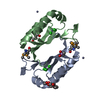
| ||||||||
|---|---|---|---|---|---|---|---|---|---|
| 1 |
| ||||||||
| 2 | 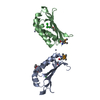
| ||||||||
| Unit cell |
| ||||||||
| Details | Dynamic Light Scattering (DLS) indicates the protein is a dimer in solution. There is one dimer in the asymmetric unit. |
- Components
Components
-Protein , 1 types, 2 molecules AB
| #1: Protein | Mass: 11305.550 Da / Num. of mol.: 2 Source method: isolated from a genetically manipulated source Source: (gene. exp.)  Haemophilus influenzae (bacteria) / Plasmid: pET15b / Production host: Haemophilus influenzae (bacteria) / Plasmid: pET15b / Production host:  |
|---|
-Non-polymers , 6 types, 342 molecules 

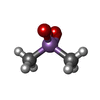
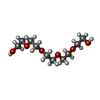
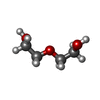






| #2: Chemical | ChemComp-ZN / #3: Chemical | ChemComp-CL / #4: Chemical | ChemComp-CAC / | #5: Chemical | ChemComp-1PE / | #6: Chemical | ChemComp-PEG / | #7: Water | ChemComp-HOH / | |
|---|
-Details
| Has protein modification | Y |
|---|
-Experimental details
-Experiment
| Experiment | Method:  X-RAY DIFFRACTION / Number of used crystals: 1 X-RAY DIFFRACTION / Number of used crystals: 1 |
|---|
- Sample preparation
Sample preparation
| Crystal | Density Matthews: 2 Å3/Da / Density % sol: 45.19 % | ||||||||||||||||||||||||||||||||||||
|---|---|---|---|---|---|---|---|---|---|---|---|---|---|---|---|---|---|---|---|---|---|---|---|---|---|---|---|---|---|---|---|---|---|---|---|---|---|
| Crystal grow | Temperature: 295 K / Method: vapor diffusion, hanging drop / pH: 5.5 Details: PEG4000, sodium cacodylate, sodium chloride, zinc acetate, dioxane, pH 5.5, VAPOR DIFFUSION, HANGING DROP, temperature 295K | ||||||||||||||||||||||||||||||||||||
| Crystal grow | *PLUS Method: vapor diffusion, hanging drop | ||||||||||||||||||||||||||||||||||||
| Components of the solutions | *PLUS
|
-Data collection
| Diffraction | Mean temperature: 100 K | |||||||||||||||
|---|---|---|---|---|---|---|---|---|---|---|---|---|---|---|---|---|
| Diffraction source | Source:  SYNCHROTRON / Site: SYNCHROTRON / Site:  APS APS  / Beamline: 17-ID / Wavelength: 0.9793, 0.9795, 0.9664, 0.9832 / Beamline: 17-ID / Wavelength: 0.9793, 0.9795, 0.9664, 0.9832 | |||||||||||||||
| Detector | Type: ADSC QUANTUM 210 / Detector: CCD / Date: Sep 23, 2001 | |||||||||||||||
| Radiation | Monochromator: Si(111) / Protocol: MAD / Monochromatic (M) / Laue (L): M / Scattering type: x-ray | |||||||||||||||
| Radiation wavelength |
| |||||||||||||||
| Reflection | Resolution: 0.99→19.45 Å / Num. all: 206507 / Num. obs: 206417 / % possible obs: 94.2 % / Observed criterion σ(I): 0 / Redundancy: 4.76 % / Rsym value: 0.063 / Net I/σ(I): 16.7 | |||||||||||||||
| Reflection shell | Resolution: 0.99→1 Å / Redundancy: 0.87 % / Mean I/σ(I) obs: 2.4 / Num. unique all: 3599 / Rsym value: 0.3486 / % possible all: 55.7 | |||||||||||||||
| Reflection | *PLUS Lowest resolution: 20 Å / Num. measured all: 1042859 / Rmerge(I) obs: 0.063 | |||||||||||||||
| Reflection shell | *PLUS Lowest resolution: 1.1 Å / % possible obs: 83.4 % / Rmerge(I) obs: 0.216 / Mean I/σ(I) obs: 6 |
- Processing
Processing
| Software |
| |||||||||||||||||||||||||||||||||
|---|---|---|---|---|---|---|---|---|---|---|---|---|---|---|---|---|---|---|---|---|---|---|---|---|---|---|---|---|---|---|---|---|---|---|
| Refinement | Method to determine structure:  MAD / Resolution: 0.99→15 Å / Num. parameters: 18707 / Num. restraintsaints: 23309 / Cross valid method: FREE R / σ(F): 0 / Stereochemistry target values: ENGH AND HUBER MAD / Resolution: 0.99→15 Å / Num. parameters: 18707 / Num. restraintsaints: 23309 / Cross valid method: FREE R / σ(F): 0 / Stereochemistry target values: ENGH AND HUBER
| |||||||||||||||||||||||||||||||||
| Refine analyze | Num. disordered residues: 25 / Occupancy sum hydrogen: 1497 / Occupancy sum non hydrogen: 1916.09 | |||||||||||||||||||||||||||||||||
| Refinement step | Cycle: LAST / Resolution: 0.99→15 Å
| |||||||||||||||||||||||||||||||||
| Refine LS restraints |
| |||||||||||||||||||||||||||||||||
| Software | *PLUS Name: SHELXL / Version: 97 / Classification: refinement | |||||||||||||||||||||||||||||||||
| Refinement | *PLUS Lowest resolution: 15 Å / % reflection Rfree: 5 % / Rfactor Rfree: 0.132 / Rfactor Rwork: 0.109 | |||||||||||||||||||||||||||||||||
| Solvent computation | *PLUS | |||||||||||||||||||||||||||||||||
| Displacement parameters | *PLUS |
 Movie
Movie Controller
Controller


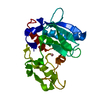
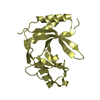
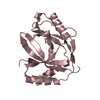
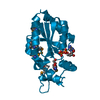
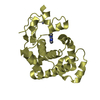
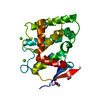
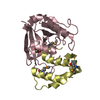
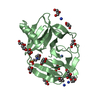
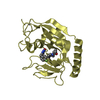
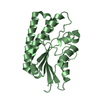
 PDBj
PDBj








